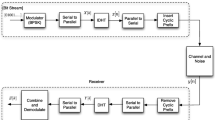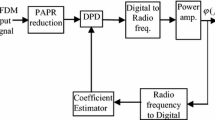Abstract
This paper proposed a novel nonlinear constellation precoding (NCP) technique based on maximum distance separable (MDS) codes in orthogonal frequency-division multiplexing (OFDM) systems. The proposed method envisage to maximize both the diversity and coding gains for any number of diversity channels and desired diversity orders. The novel NCP technique combined with subcarrier groping in OFDM systems to replace the most existing linear constellation precoding (LCP) scheme. In this scheme, the full set of subcarriers are splitted into smaller groups and the codewords are constructed from \(q\) point constellation mapper with MDS encoder. The maximum-likelihood (ML) decoder is used in the most existing signal space diversity technique which is replaced by diversity channel selection (DCS) to reduce the decoding complexity with the cost of marginal performance loss. The effect of the Inter-carrier interference (ICI) introduced by the carrier frequency offsets (CFO) also analyzed in the proposed OFDM system. The superiority of the proposed novel NCP technique over the previously proposed designs is verified by simulation results.










Similar content being viewed by others
References
Le, K. N. (2008). Inter-carrier interference power of OFDM in a uniform scattering channel. Computer Communications, 31, 4130–4135.
Chang, D.-C., Lai Y.-L., Hsu Y.-C. (2010). ICI compensation for interleaved OFDMA with carrier frequency offsets. In Proceedings of the IEEE international symposium on broadband multimedia systems and broadcasting (BMSB), pp. 1–5, 2010.
Le, K. N. (2008). Insights on ICI and its effects on performance of OFDM systems. Digital Signal Processing, 18(6), 876–884.
Le, K. N. (2008). Bounds on inter-carrier interference power of OFDM in a Gaussian scattering channel. Wireless Personal Commununications, 47(3), 355–362.
Le, K. N. (2010). BER of OFDM in Rayleigh fading environments with selective diversity. Wireless Communication and Mobile Computing, 10(2), 306–311.
Hong, Z., Zhang, L. & Thibault, L. (2011). Iterative ICI cancellation for OFDM receiver with residual carrier frequency offset. In Proceedings of the IEEE vehicular technology conference (VTC Fall), pp. 1–5, 2011.
Le, K. N., & Dabke, K. P. (2010). BER of OFDM with diversity and pulse shaping in Rayleigh fading environments. Digital Signal Processing, 20(6), 1687–1696.
Le, K. N. (2011). Additional insight on SAGE-based carrier and residual frequency offset estimations in OFDM systems. Wireless Personal Commununications, 60(4), 687–694.
Mahesh, R. U., & Chaturvedi, A. K. (2010). Closed form BER expressions for BPSK OFDM systems with frequency offset. IEEE Communications Letters, 14(8), 731–733.
Saxena, R. & Joshi, H.D. (2012). ICI reduction in OFDM system using IMBH pulse shapes, wireless personal communication, Springer Publication, pp. 1–17, published online: December 2012. doi:10.1007/s11277-012-0978-7.
Boutros, J., & Viterbo, E. (1998). Signal space diversity: A power- and bandwidth-efficient diversity technique for the Rayleigh fading channel. IEEE Transactions on, Information Theory, 44, 1453–1467.
Giraud, X., Boutillon, E., & Belfiore, J. C. (1997). Algebraic tools to build modulation schemes for fading channels. IEEE Transactions on, Information Theory, 43, 938–952.
Goeckel, D. L., & Ananthaswamy, G. (2002). On the design of multidimensional signal sets for OFDM systems. IEEE Transactions on Communications, 50, 442–452.
McCloud, M. L. (2005). Analysis and design of short block OFDM spreading matrices for use on multipath fading channels. IEEE Transactions on Communications, 53, 656–665.
El Gamal, H., & Hammons, A. R. (2001). A new approach to layered space-time coding and signal processing. IEEE Transactions on, Information Theory, 47, 2321–2334.
El Damen, M. O., Abed-Meraim, K., & Belfiore, J. C. (2002). Diagonal algebraic space-time block codes. IEEE Transactions on, Information Theory, 48, 628–636.
Wang, H., & Xia, X.-G. (2008). Optimal normalized diversity product of \(2\times 2\) lattice-based diagonal space-time codes from QAM signal constellations. IEEE Transactions on, Information Theory, 54, 1814–1818.
Lamy, C., & Boutros, J. (2000). On random rotations diversity and minimum MSE decoding of lattices. IEEE Transactions on, Information Theory, 46, 1584–1589.
Liu, Z., Xin, Y., & Giannakis, G. B. (2002). Space-time-frequency coded OFDM over frequency-selective fading channels. IEEE Transactions on, Signal Processing, 50, 2465–2476.
Wang, Z., & Giannakis, G. B. (2003). Complex-field coding for OFDM over fading wireless channels. IEEE Transactions on, Information Theory, 49, 707–720.
Lin, R., & Petropulu, A. P. (2005). Linear precoding assisted blind channel estimation for OFDM systems. IEEE Transactions on, Vehicular Technology, 54, 983–995.
Liu, Z., Xin, Y., & Giannakis, G. B. (2001). Linear constellation-precoding for OFDM with maximum multipath diversity and coding gains. In Proceedings of the 35 Asilomar conference on signals, systems and computers, pp. 1445–1449.
Tran, N. H., Nguyen, H. H., & Tho, Le-Ngoc. (2007). Subcarrier grouping for OFDM with linear constellation precoding over multipath fading channels. IEEE Transactions on, Vehicular Technology, 56, 3607–3613.
Shang, Y., Wang, D., & Xia, T. X.-G. (2010). Signal space diversity techniques with fast decoding based on MDS codes. IEEE Transactions on, Communications, 58, 2525–2536.
Seyedi, A. (2006). Multi-QAM modulation: A low-complexity full-rate diversity scheme. In Proceedings of the IEEE international conference on, communications, pp. 1470–1475.
Simon, M. K., & Aluini, M.-S. (2005). Digital communication over fading channels (2nd ed.). New York: Wiley.
Raja, M., & Muthuchidambaranathan, P. (2010). BER performance of SVD-based transmit beamforming with various modulation techniques. In Proceedings of 5th IEEE international conference on industrial and, information systems (ICIIS-2010), pp. 155–160, 2010.
Author information
Authors and Affiliations
Corresponding author
Rights and permissions
About this article
Cite this article
Raja, M., Muthuchidambaranathan, P. A Novel Nonlinear Constellation Precoding for OFDM Systems with Subcarrier Grouping. Wireless Pers Commun 73, 867–884 (2013). https://doi.org/10.1007/s11277-013-1221-x
Published:
Issue Date:
DOI: https://doi.org/10.1007/s11277-013-1221-x




